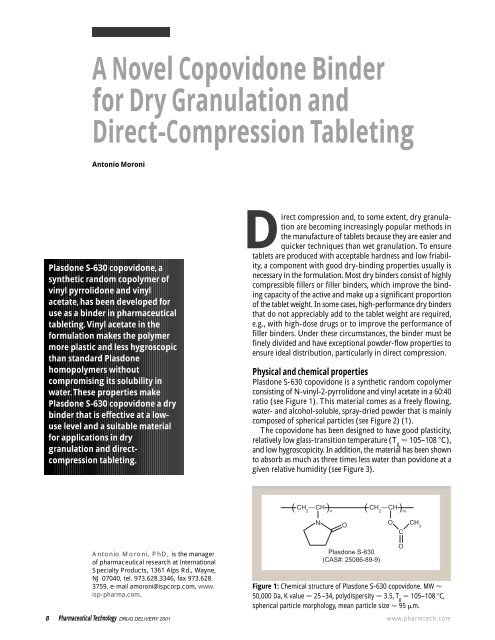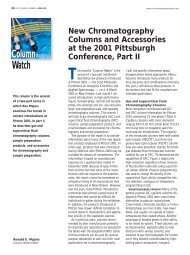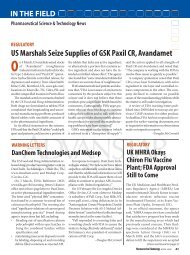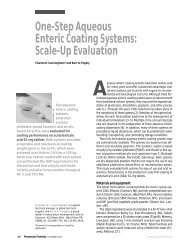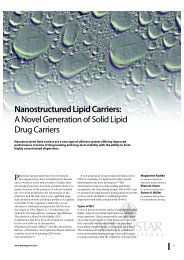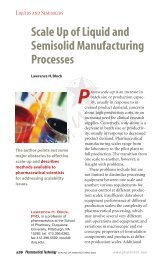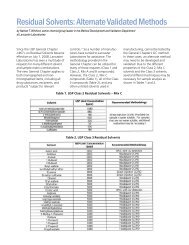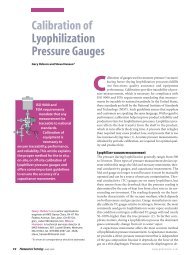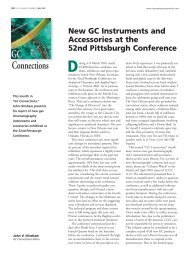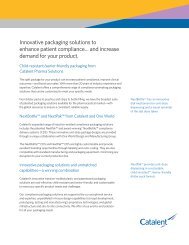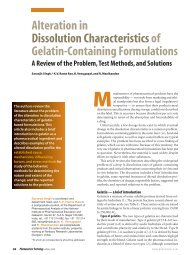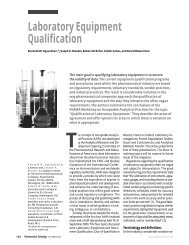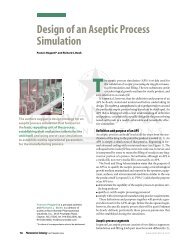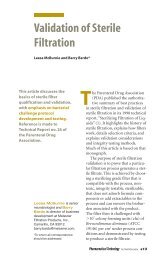A Novel Copovidone Binder for Dry Granulation and
A Novel Copovidone Binder for Dry Granulation and
A Novel Copovidone Binder for Dry Granulation and
You also want an ePaper? Increase the reach of your titles
YUMPU automatically turns print PDFs into web optimized ePapers that Google loves.
A <strong>Novel</strong> <strong>Copovidone</strong> <strong>Binder</strong><br />
<strong>for</strong> <strong>Dry</strong> <strong>Granulation</strong> <strong>and</strong><br />
Direct-Compression Tableting<br />
Antonio Moroni<br />
Plasdone S-630 copovidone, a<br />
synthetic r<strong>and</strong>om copolymer of<br />
vinyl pyrrolidone <strong>and</strong> vinyl<br />
acetate, has been developed <strong>for</strong><br />
use as a binder in pharmaceutical<br />
tableting. Vinyl acetate in the<br />
<strong>for</strong>mulation makes the polymer<br />
more plastic <strong>and</strong> less hygroscopic<br />
than st<strong>and</strong>ard Plasdone<br />
homopolymers without<br />
compromising its solubility in<br />
water.These properties make<br />
Plasdone S-630 copovidone a dry<br />
binder that is effective at a lowuse<br />
level <strong>and</strong> a suitable material<br />
<strong>for</strong> applications in dry<br />
granulation <strong>and</strong> directcompression<br />
tableting.<br />
Antonio Moroni, PhD, is the manager<br />
of pharmaceutical research at International<br />
Specialty Products, 1361 Alps Rd., Wayne,<br />
NJ 07040, tel. 973.628.3346, fax 973.628.<br />
3759, e-mail amoroni@ispcorp.com, www.<br />
isp-pharma.com.<br />
Direct compression <strong>and</strong>, to some extent, dry granulation<br />
are becoming increasingly popular methods in<br />
the manufacture of tablets because they are easier <strong>and</strong><br />
quicker techniques than wet granulation. To ensure<br />
tablets are produced with acceptable hardness <strong>and</strong> low friability,<br />
a component with good dry-binding properties usually is<br />
necessary in the <strong>for</strong>mulation. Most dry binders consist of highly<br />
compressible fillers or filler binders, which improve the binding<br />
capacity of the active <strong>and</strong> make up a significant proportion<br />
of the tablet weight. In some cases, high-per<strong>for</strong>mance dry binders<br />
that do not appreciably add to the tablet weight are required,<br />
e.g., with high-dose drugs or to improve the per<strong>for</strong>mance of<br />
filler binders. Under these circumstances, the binder must be<br />
finely divided <strong>and</strong> have exceptional powder-flow properties to<br />
ensure ideal distribution, particularly in direct compression.<br />
Physical <strong>and</strong> chemical properties<br />
Plasdone S-630 copovidone is a synthetic r<strong>and</strong>om copolymer<br />
consisting of N-vinyl-2-pyrrolidone <strong>and</strong> vinyl acetate in a 60:40<br />
ratio (see Figure 1). This material comes as a freely flowing,<br />
water- <strong>and</strong> alcohol-soluble, spray-dried powder that is mainly<br />
composed of spherical particles (see Figure 2) (1).<br />
The copovidone has been designed to have good plasticity,<br />
relatively low glass-transition temperature (T g 105–108 C),<br />
<strong>and</strong> low hygroscopicity. In addition, the material has been shown<br />
to absorb as much as three times less water than povidone at a<br />
given relative humidity (see Figure 3).<br />
( CH 2 —CH ) n<br />
Plasdone S-630<br />
(CAS#: 25086-89-9)<br />
( CH 2 —CH ) m<br />
8 Pharmaceutical Technology DRUG DELIVERY 2001 www.pharmtech.com<br />
N<br />
O<br />
O<br />
C<br />
O<br />
CH 3<br />
Figure 1: Chemical structure of Plasdone S-630 copovidone. MW <br />
50,000 Da, K value 25–34, polydispersity 3.5, T g 105–108 C,<br />
spherical particle morphology, mean particle size 95 m.
Figure 2: SEM micrography of Plasdone S-630 copovidone.<br />
The copovidone’s flowability, hygroscopicity, <strong>and</strong> plasticity<br />
make it a highly suitable excipient <strong>for</strong> hard-to-compress or<br />
moisture-sensitive drugs <strong>and</strong> may improve storage stability.<br />
Figure 4 shows its compressibility in comparison with other<br />
direct-compression binders.<br />
This material is listed in several pharmacopeia under the following<br />
nomenclature:<br />
● <strong>Copovidone</strong> NF (draft published)<br />
● Copolyvidonum Ph Eur<br />
● Copolyvidon DAB<br />
● Copolyvidone JSPI<br />
Applications<br />
The physical properties of Plasdone S-630 copovidone (flowability,<br />
hygroscopicity, spherical particle shape, binding strength,<br />
glass-transition temperature, <strong>and</strong> hydrophobic–hydrophilic<br />
balance) may offer significant advantages in the roller-compaction<br />
<strong>and</strong> direct-compression processes involved in pharmaceutical<br />
tablet manufacturing. The copovidone can be used<br />
separately or in combination with lactose, dicalcium phosphate<br />
(DCP), <strong>and</strong> microcrystalline cellulose (MCC) as a dry binder<br />
in the roller-compaction process to produce granules with good<br />
flow <strong>and</strong> bulk density. The product also can be used to make<br />
effervescent tablets by direct-compression techniques, instead<br />
of the use of solvent-based anhydrous wet granulation. The<br />
material is water soluble <strong>and</strong> will produce a clear liquid upon<br />
dissolution.<br />
The properties of Plasdone S-630 copovidone were evaluated<br />
in a study targeted to assess the compressibility of Plasdone<br />
S-630 copovidone–based tablet <strong>for</strong>mulations both in<br />
roller compaction <strong>and</strong> direct compression. Two factors were<br />
studied: the effect of the presence or absence of a filler or binder<br />
(MCC) <strong>and</strong> the tableting properties in the presence of both<br />
water-soluble (e.g., directly compressible [DC] lactose) <strong>and</strong> insoluble<br />
(e.g., DCP) fillers, thus comparing hydrophobic <strong>and</strong><br />
hydrophilic excipients.<br />
Experimental conditions<br />
Directly compressed <strong>for</strong>mulations. Hydrochlorothiazide (HCTZ)<br />
was used as a model drug <strong>for</strong> eight different <strong>for</strong>mulations. Table<br />
I lists the components of the <strong>for</strong>mulations <strong>and</strong> their percentages.<br />
Formulations were either directly compressed or roller<br />
compacted, granulated, <strong>and</strong> then compressed.<br />
% Moisture<br />
100<br />
80<br />
60<br />
40<br />
20<br />
Plasdone K-29/32<br />
Plasdone S-630<br />
0<br />
0 20 40 60 80 100<br />
% Relative humidity<br />
Figure 3: Moisture absorption profiles of Plasdone S-630 copovidone<br />
<strong>and</strong> povidone.<br />
Hardness (kp)<br />
50<br />
40<br />
30<br />
20<br />
10<br />
0<br />
<br />
<br />
Roller-compacted <strong>for</strong>mulations. HCTZ <strong>and</strong> acetylsalicylic acid<br />
(ASA) were used as model drugs <strong>for</strong> roller-compacted <strong>for</strong>mulations.<br />
Table II lists the components of the HCTZ <strong>for</strong>mulations<br />
<strong>and</strong> their percentages, <strong>and</strong> Table III lists these <strong>for</strong> the ASA<br />
<strong>for</strong>mulations.<br />
Roller-compacted <strong>for</strong>mulation ribbons were prepared as<br />
described in Table IV to evaluate, in addition to the binder<br />
type, the effect of the roller-compaction factors on the final<br />
tablets’ per<strong>for</strong>mances through a fractional factorial experimental<br />
design. Tableting was per<strong>for</strong>med in a rotary press<br />
(Stokes, Bristol, PA) at compression <strong>for</strong>ces of 6000 lbs (1 lb<br />
<strong>for</strong>ce 4.448 N). Tablets were subjected to various physical<br />
tests, including tests to evaluate hardness, friability, disintegration,<br />
<strong>and</strong> dissolution.<br />
Results <strong>and</strong> discussion<br />
Directly compressed <strong>for</strong>mulations. Initial <strong>for</strong>mulations were prepared<br />
keeping MCC fixed at 18% <strong>and</strong> using Plasdone S-630<br />
copovidone at either 0% or 10% levels. As levels of copovidone<br />
were increased, the <strong>for</strong>mulation was compensated with decreasing<br />
amounts of filler (lactose or DCP) while maintaining<br />
the level of MCC. The following results were obtained (2):<br />
<br />
<br />
2000 4000<br />
Compression <strong>for</strong>ce (lb)<br />
6000<br />
Plasdone S-630 MCC Lactose DT<br />
HPMC 15 cps Dicalcium phosphate<br />
Figure 4: Compressibility profiles of Plasdone S-630 copovidone <strong>and</strong><br />
other binders.<br />
Pharmaceutical Technology DRUG DELIVERY 2001 9
Table I: HCTZ directly compressed <strong>for</strong>mulations.<br />
Component Percentage Range (% w/w)<br />
Hydrochlorothiazide (HCTZ) 25<br />
MCC 101 18–28<br />
DC lactose or dicalcium phosphate 44–54<br />
Plasdone S-630 copovidone 10–0<br />
Polyplasdone crospovidone XL 2<br />
Colloidal silicon dioxide 0.5<br />
Magnesium stearate 0.5<br />
Total 100<br />
Table III: ASA roller-compacted <strong>for</strong>mulations.<br />
Component Percentage Range (% w/w)<br />
Acetylsalicylic acid (ASA) 80<br />
<strong>Binder</strong> (Plasdone S-630 copovidone,<br />
HPMC 15 cps, MCC 101) 5<br />
DC lactose filler 10<br />
Polyplasdone crospovidone XL 3<br />
Colloidal silicon dioxide 1<br />
Magnesium stearate 1<br />
Total 100<br />
● Hardness. Higher levels of Plasdone S-630 copovidone led to<br />
a marginal increase in tablet hardness when DC lactose was<br />
used. Tablets <strong>for</strong>mulated with DCP had a greater increase in<br />
tablet hardness.<br />
● Ejection <strong>for</strong>ce. Ejection <strong>for</strong>ce was reduced in <strong>for</strong>mulations<br />
that contained Plasdone S-630 copovidone.<br />
● Friability <strong>and</strong> disintegration. Marginal improvements were<br />
observed in <strong>for</strong>mulations that contained Plasdone S-630<br />
copovidone <strong>and</strong> DCP or DC lactose.<br />
● Dissolution. Increasing the level of Plasdone S-630 copovi-<br />
(a) DC Lactose filler (b) DCP filler<br />
Hardness (KPa)<br />
20<br />
15<br />
10<br />
5<br />
S-630 10%<br />
No S-630<br />
0<br />
0 2000 4000 6000 8000<br />
Compression <strong>for</strong>ce (lb)<br />
Table V: Hardness of HCTZ <strong>and</strong> ASA tablets compressed at 6000 lb<br />
from roller-compacted <strong>for</strong>mulations.*<br />
Plasdone S-630 copovidone MCC HPMC 15 cps<br />
Drug 4 rpm 8 rpm 4 rpm 8 rpm 4 rpm 8 rpm<br />
HCTZ 6.7 5.7 4.7 4.4 5.4 5.2<br />
ASA 6.9 6.5 6.8 6.1 6.9 6.4<br />
* Values are shown <strong>for</strong> roll speeds of 4 <strong>and</strong> 8 rpm.<br />
Hardness (KPa)<br />
20<br />
16<br />
12<br />
8<br />
4<br />
S-630 10%<br />
No S-630<br />
Table II: HCTZ roller-compacted <strong>for</strong>mulations.<br />
Component Percentage Range (% w/w)<br />
Hydrochlorothiazide (HCTZ) 76.5<br />
<strong>Binder</strong> (Plasdone S-630 copovidone,<br />
HPMC 15 cps, MCC 101) 5<br />
DC lactose filler 15<br />
Polyplasdone crospovidone XL 2<br />
Colloidal silicon dioxide 0.5<br />
Magnesium stearate 0.5<br />
Total 100<br />
Table IV: Roller compaction factors.<br />
Factor Low Level High Level<br />
Feed-screw rate (rpm) 8 24<br />
Roll speed (rpm) 4 8<br />
Roll pressure (ton) 1 2<br />
done from 0% to 10% did not alter the dissolution profiles<br />
of tablets <strong>for</strong>mulated with DC lactose or DCP. All <strong>for</strong>mulations<br />
passed the USP dissolution tolerance criteria.<br />
Figure 5 shows the hardness profiles of tablets containing 0%<br />
or 10% Plasdone S-630 copovidone substituting filler.<br />
A second set of <strong>for</strong>mulations then was prepared keeping filler<br />
level constant (DC lactose or DCP) but substituting as much<br />
as 10% MCC with Plasdone S-630 copovidone. The goal was<br />
to compare these <strong>for</strong>mulations directly with those containing<br />
MCC.<br />
The following results were obtained:<br />
● Hardness. Tablets <strong>for</strong>mulated with DC lactose <strong>and</strong> those <strong>for</strong>mulated<br />
with DCP were as hard or harder when Plasdone S-<br />
630 copovidone was used in place of 10% MCC.<br />
● Disintegration. Disintegration times were less than 1 min <strong>for</strong><br />
all tablets at all compression <strong>for</strong>ces,<br />
<strong>and</strong> no significant differences were<br />
observed in dissolution profiles<br />
among concentrations at 30 min.<br />
0<br />
0 2000 4000 6000 8000<br />
Compression <strong>for</strong>ce (lb)<br />
Figure 5: Hardness of directly compressed HCTZ <strong>for</strong>mulations in which Plasdone S-630 copovidone has<br />
replaced 10% filler <strong>for</strong> (a) DC lactose filler <strong>and</strong> (b) DCP filler.<br />
Figure 6 shows the tablet responses<br />
measured at 0% <strong>and</strong><br />
10% concentration levels of the<br />
Plasdone S-630 copovidone,<br />
keeping MCC levels at 28% <strong>and</strong><br />
18% respectively.<br />
From these results, it appears<br />
that the addition of Plasdone S-<br />
630 copovidone (as much as 10%)<br />
to <strong>for</strong>mulations can improve hardness,<br />
lower ejection <strong>for</strong>ce, <strong>and</strong> reduce<br />
friability without loss in dissolution<br />
per<strong>for</strong>mance. MCC can<br />
be partly substituted by Plasdone<br />
S-630 copovidone to achieve enhanced<br />
compressibility, <strong>and</strong> thus<br />
it can be used as a direct-compression<br />
binder aid <strong>for</strong> the augmentation<br />
of tablet characteristics.<br />
Roller-compacted <strong>for</strong>mulations.<br />
Roller-compacted <strong>for</strong>mulations<br />
10 Pharmaceutical Technology DRUG DELIVERY 2001 www.pharmtech.com
(a) DC Lactose filler (b) DCP filler<br />
Hardness (KPa)<br />
Ejection <strong>for</strong>ce (lb)<br />
20<br />
15<br />
10<br />
5<br />
S-630 10%MCC 28%<br />
MCC 28%<br />
0<br />
0 2000 4000 6000 8000<br />
Compression <strong>for</strong>ce (lb)<br />
100<br />
80<br />
60<br />
40<br />
20<br />
0<br />
S-630 10%MCC 18%<br />
MCC 28%<br />
0 2000 4000 6000 8000<br />
Compression <strong>for</strong>ce (lb)<br />
Hardness (KPa)<br />
(c) DC Lactose filler (d) DCP filler<br />
Ejection <strong>for</strong>ce (lb)<br />
(e) DC Lactose filler (f) DCP filler<br />
Friability (%)<br />
4<br />
3<br />
2<br />
1<br />
S-630 10%MCC 18%<br />
MCC 28%<br />
Friability (%)<br />
20<br />
15<br />
10<br />
5<br />
S-630 10%MCC 18%<br />
MCC 28%<br />
0<br />
0 2000 4000 6000 8000<br />
Compression <strong>for</strong>ce (lb)<br />
100<br />
80<br />
60<br />
40<br />
20<br />
0<br />
S-630 10%MCC 18%<br />
MCC 28%<br />
0 2000 4000 6000 8000<br />
Compression <strong>for</strong>ce (lb)<br />
0<br />
0<br />
0 2000 4000 6000 8000 0 2000 4000 6000 8000<br />
Compression <strong>for</strong>ce (lb)<br />
Compression <strong>for</strong>ce (lb)<br />
3<br />
2.5<br />
2<br />
1.5<br />
1<br />
0.5<br />
S-630 10%MCC 18%<br />
MCC 28%<br />
Figure 6: Characteristics of directly compressed HCTZ <strong>for</strong>mulations in which Plasdone S-630 has<br />
replaced 10% MCC: hardness of HCTZ tablets <strong>for</strong> (a) DC lactose filler <strong>and</strong> (b) DCP filler; ejection <strong>for</strong>ce of<br />
HCTZ tablets <strong>for</strong> (c) DC lactose filler <strong>and</strong> (d) DCP filler; <strong>and</strong> friability of HCTZ tablets <strong>for</strong> (e) DC lactose<br />
filler <strong>and</strong> (f) DCP filler.<br />
% Dissolved<br />
120<br />
100<br />
80<br />
60<br />
40<br />
20<br />
Plasdone S-630<br />
HPMC 15 cps<br />
MCC<br />
0<br />
0 20 40<br />
Time (min)<br />
60 80<br />
Figure 7: Dissolution profiles of roller-compacted ASA <strong>for</strong>mulations<br />
(6000 lb, 4 rpm) with 5% of Plasdone S-630 copovidone, MCC 101, or<br />
HPMC 15 cps binder.<br />
were prepared at higher drug loading,<br />
<strong>and</strong> the binding per<strong>for</strong>mance<br />
of Plasdone S-630 copovidone was<br />
compared with those of commonly<br />
used binders such as MCC<br />
or hydroxypropylmethyl cellulose<br />
(HPMC) 15 cps.<br />
Results obtained show the following<br />
trends (3):<br />
● Effect of compaction parameters<br />
on final tablet hardness. The<br />
use of a lower roll speed produced<br />
harder tablets with both<br />
drugs, a confirmation of the<br />
plastic behavior of the three<br />
binders. Feed-screw rate <strong>and</strong> roll<br />
pressure did not have a significant<br />
effect on final hardness.<br />
● Hardness. As shown in Table V,<br />
HCTZ tablets made with Plasdone<br />
S-630 copovidone show a<br />
substantially improved hardness<br />
in comparison with tablets<br />
made with HPMC or MCC.<br />
ASA tablets made with Plasdone<br />
S-630 copovidone showed similar<br />
hardness to tablets made<br />
with both MCC <strong>and</strong> HPMC 15<br />
cps.<br />
● Dissolution. HCTZ tablets made<br />
with all three binders showed<br />
similar dissolution profiles. ASA<br />
tablets made with MCC showed<br />
slower dissolution profiles than<br />
did tablets made with either<br />
Plasdone S-630 copovidone or<br />
HPMC 15 cps (see Figure 7).<br />
Conclusion<br />
Plasdone S-630 copovidone has been shown to be a good rollercompaction<br />
binder, <strong>and</strong> its addition to directly compressed <strong>for</strong>mulations<br />
has been shown to improve tablet hardness substantially.<br />
Tablets made with Plasdone S-630 copovidone show<br />
higher hardness <strong>and</strong>/or better drug dissolution profiles than<br />
those made with other binders. For additional in<strong>for</strong>mation<br />
about Plasdone S-630 copovidone, contact the author.<br />
References<br />
1. ISP technical bulletin, Pharma/PLASS630.0800.<br />
2. A. Moroni, M. Nerella, <strong>and</strong> G. DuBrowny, “Plasdone S-630 as High-<br />
Per<strong>for</strong>mance <strong>Binder</strong> <strong>for</strong> <strong>Dry</strong> <strong>Granulation</strong>,” presented at the 2000 AAPS<br />
meeting, Indianapolis, Indiana, 29 October–2 November 2000.<br />
3. A. Moroni, M. Nerella, <strong>and</strong> G. DuBrowny, “Plasdone S-630 Mixes as<br />
<strong>Dry</strong> <strong>Granulation</strong> <strong>Binder</strong>s with Improved Per<strong>for</strong>mance,” presented at<br />
the AAPS Pharmaceutical Congress of the Americas, Orl<strong>and</strong>o, Florida,<br />
24–29 March 2001. PT<br />
12 Pharmaceutical Technology DRUG DELIVERY 2001 www.pharmtech.com


